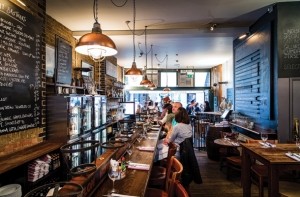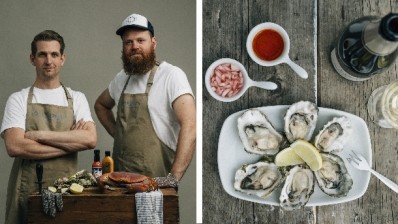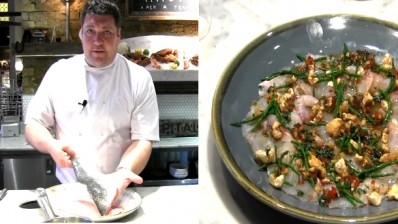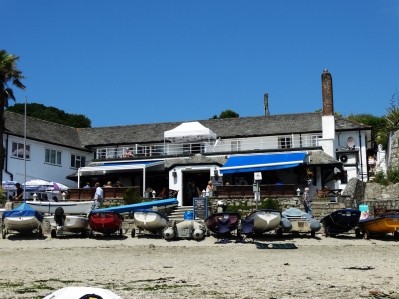Wright Brothers: Why the UK is now their oyster
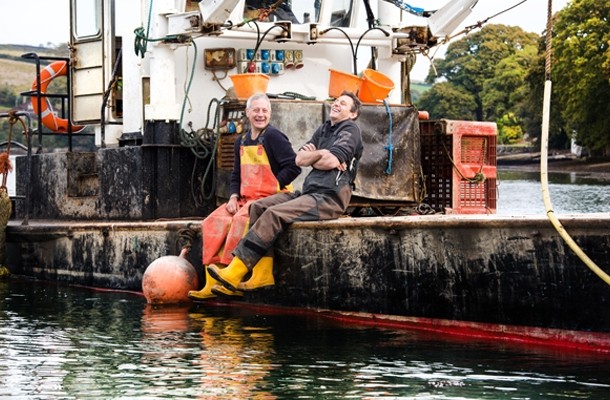
With a growing group of London restaurants also under their belts the pair are now set on spreading their mollusc mastery across the country.
In her 1941 novel Frenchman’s Creek, Daphne du Maurier tells the story of a love affair between an English lady and a French pirate, set in a sleepy Cornish village. The story centres around Navron, a remote private residence, inspired by the Trelowarren Estate that sits by the Helford River, five miles south of Falmouth, with a powerful English/Gallic relationship unfolding within its pages.
Seventy years on and the relationship between England and its friends across the Channel continues to flourish on the shores of the Helford River. This time, however, it’s one driven by a shared love of food. More aptly, it’s founded on the most famous of all the aphrodisiacs – the oyster – consignments of which make their way from there to France on a regular basis.
These days, when people talk of Frenchman’s Creek they’re unlikely to be discussing du Maurier’s story of swashbuckling and derring-do, but rather the stretch of water on the Helford River. That or the Pacific oysters of the same name that have been harvested on the river by the Wright Brothers since 2005 and which can be found across London’s top restaurant tables and beyond.
Oyster business
Today, it’s not hard to find a decent selection of oysters in the capital. As well as supplying more than 140 restaurants with native and Pacific oysters, the Wright Brothers business also sells prized molluscs from places including Morecambe Bay, Essex, the Isle of Cumbrae, Lindisfarne and Carlingford through its wholesale seafood business. In addition, the company runs four successful London seafood restaurants, in Borough Market, Spitalfields, Soho and South Kensington, as well as The Ferryboat Inn pub overlooking its oyster farm.
Yet it was a different story when its founders Ben Wright and Robin Hancock launched their oyster wholesale business in 2002. Back then oysters were still something of a rarity in the big cities and the pair found themselves touring London’s kitchens trying to convince chefs to taste what they had to offer. “When we think back to 2002, it’s not like everyone was eating oysters,” recalls Hancock. “It was very much a product of a select few restaurants. People were serving them in St James, Harrods and Selfridges but not many other places. We had to change people’s perceptions of them.”
If the idea of buying oysters was hard for some chefs to swallow at the time, encouraging them to buy direct from a duo that hitherto had virtually no experience of seafood made Hancock and Wright’s task even more of a challenge. The pair met when Hancock, a music industry producer working with the likes of Billy Idol and Madonna, started dating Wright’s sister, Susie (who is now his wife).
Wright, who had been a corporate lawyer, had decided on a change of career while living in Paris, where he made friends with Jerome Miet, one of the biggest oyster farmers in France. He then convinced Hancock to help him set up Wright Brothers to sell Jerome’s Speciales and Fine de Claire oysters in the UK.
Thanks to a combination of good timing, high-quality product and a knack for cajoling influential chefs to try their wares, Wright Brothers flourished in its early days. Working from the front rooms of their flats and driving to Heathrow at four o’clock each morning for deliveries, early on the pair captured the imagination of chefs including Mark Hix, Tim Hughes, Henry Harris and Mitch Tonks.
With their endorsement, demand for their oysters started to spread throughout the restaurant industry. Three years later they relocated the business to Borough Market and also opened the first of their seafood restaurants. At the same time, the opportunity arose to lease The Duchy of Cornwall Oyster Farm in Helford – following a regeneration programme – from the Duke of Cornwall, HRH The Prince of Wales. Two types of oysters are cultivated at Duchy Oyster Farm – Duchy Natives and Frenchman’s Creek – with the farm harvesting some 17 million native and Pacific oysters each year.
Time is an important factor in oyster cultivation and harvesting. For Wright Brothers’ Pacific oysters, seed is sourced from a hatchery in Guernsey, so as not to deplete any wild stocks. To reach a fully grown,
market-size oyster takes two-and-a-half to three years of cultivating, turning and grading – and double that time for natives. As such, Hancock and Wright are no strangers to a slow burn.
This process has been mirrored in the company’s growth, from its early days as an oyster wholesaler to the large-scale oyster farm, seafood merchants and restaurant group operation it now runs.
Seafood restaurants
Growth has been steady, with the company’s second restaurant opening in Soho in 2010 and its third in Spitalfields at the end of 2013. Its most recent, in London’s South Kensington, opened earlier this year.
“It has taken us 13 years to get to where we are, we are not an overnight company,” says Wright. “You’ve got to be in it for the long haul.”
With four London restaurants as well as a Cornish pub, the pair now have their sites further afield. Next year they will move their wholesale seafood business from Borough to Billingsgate to help boost national distribution of its oysters and seafood and also intend to introduce their restaurants to other large cities in the UK.
“We, hopefully, will have lots of Wright Brothers in neighbourhood locations, which is what Fishworks never succeeded in doing,”says Hancock. “With the growing restaurant competition in London and the current rent situation we are definitely looking at what everyone else is doing in provincial sites as well. The provinces are growing up. They want to have access to the same things that people in London have access to.”
“The Wright Brothers model is not terribly complicated,” adds Wright. “People understand they are eating good quality seafood at a very good price point. We believe we can put a Wright Brothers in Bristol, Liverpool and Manchester and also supply the restaurants there with great wholesale seafood. The idea is to start reaching out to major cities with our wholesale business and grow from there.
“We recognise that demand for oysters is not going to turn round overnight, but there are always some people who get it straight away. About 10 chefs, such as Mark Hix and Henry Harris, got what we were about from the start; maybe outside of London it’s a core five people instead. But that’s what you build it on and then you work on the rest.”
The pair also believe the reason why other UK cities haven’t yet embraced the oyster as readily as London is down more to a past lack of supply than low demand for them. “Liverpool has a history with oysters because they are shipped there from Ireland. But there’s not the variety there that we now have in London. That’s where the opportunity is,” says Hancock.
"The story we came to the London market with in 2002 was new and we need to take that message to other places,” adds Wright. “It’s not about the demand it’s about the supply. If you can’t supply oysters you can’t say people don’t like them. If you supply them you find that people do like them. I don’t think chefs in Manchester have a choice of 12 different oysters depending on season, and they should. That should be the next chapter in our story.”
Quality and quantity
Running its own oyster farm gives Wright Brothers a clear edge when looking to disseminate its seafood message. It not only means that it can guarantee supply, but also quality, a prerequisite for a product that is served to the customer with only minimal intervention from the kitchen. Wright Brothers’ wholesale element will also help foster demand for oysters in new markets in a way that a standalone restaurant cannot.
“The strategy is to go to Manchester or Birmingham and not just open a restaurant, but grow a Wright Brothers in the same way that we grew from a wholesale business into a restaurant,” says Wright. “We will have a wholesale base there – just one little van, not 20 – which will run around the restaurants. We will then also find a nice little neighbourhood site to do the fish we’re supplying to everyone else. It will help us to do it organically.”
The pair brush off the idea that they might first use their wholesale business to dip their toe in the water before laying down restaurant roots.
“You’ve got to have that belief in what you do. We won’t rely on other restaurants to buy our seafood,” says Wright. “If chefs don’t take it, that’s fine, but it’s an opportunity for them to be the first place to serve a selection of different oysters.
“We know that we can do it. It’s not frightening or a big mountain to climb. There is work to be done, but there will be a minority in those cities who will say ‘thank god you’re here, we can now eat this great product’. We started out small and we can do it again.”
The company’s approach to its restaurants is also likely to put it in good stead as it expands further. Each restaurant’s interior design is individual and done to a high spec and yet the dining rooms are more approachable than many of the capital’s other seafood restaurants of similar ambition. Its smart Soho site, which backs on to the new foodie courtyard that is Kingly Court, functions as a popular bar while its Borough restaurant has a slightly more rough-and-ready feel to it, in keeping with its location. South Kensington, meanwhile, features a super-slick downstairs Mermaid Bar that attracts a more late night, drink-led crowd.
Wright Brothers’ focus on the cooking, with menus that tread carefully between traditional and modern, also gives its restaurants more widespread appeal than many of its competitors.
Its head chef at Soho, Sasha Ziverts, is formerly of Will Ricker’s pan-Asian restaurant Eight over Eight, for example, and he has introduced an Asian slant to the seafood menu with additions such as salmon ceviche, miso soup with pancetta and clams, and tempura soft shell crab.
Oyster shack: Shuck
The pair have another ace up their sleeves to potentially smooth their entry into regional markets as well as to further grow demand for oysters in the capital: Shuck.
What started out as a short-term oyster shack in Borough market – it ran for six months last Easter – is soon to become a permanent element of the brand.
The original Shuck took inspiration from the growing street food movement – and also from the fact that the oyster cart was a common fixture of 19th-century London’s East End – serving oysters done a few ways and with a handful of different drinks on tap.
Shuck’s punky approach, with its blow torched oysters and stripped back decor, has not only helped democratise the oyster even more, but it fleetingly opened up the brand to a new, younger clientele that otherwise might have never set foot in one of its restaurants.
“Shuck was just really fun; it got out of control,” says Hancock. “It was a good testing ground. We’d done a bit of street food and it was a further move into that area. We discovered that there was a whole young audience out there that wanted seafood.”
Based on the success of the pop-up, the pair are now looking for a permanent home for Shuck, not just in London, but to also support any new Wright Brothers it might open across the country. Because there is no cooking done on site, it can potentially go into A1 locations, which will help with expansion plans. Under the arches in Waterloo has been mooted as a possible location in 2017, but the first Shuck will open somewhere else before then.
In its permanent guise, Shuck may have a slightly broader reach with a wider menu, says Hancock, but its approach to serving affordable seafood in a very informal setting will remain the same.
Dealing with oysters
Dealing with oysters has its obvious drawbacks, not least the care required to cultivate and harvest them, the capricious temper of Mother Nature and the food safety concerns that come with dealing with raw shellfish. As such, running a growing chain of seafood restaurants as well as a pub has not always been plain sailing.
Settling on the style of each restaurant has been a work in progress. The design of the Spitalfields dining room, for example, was roundly applauded for its live seafood tanks – it was named Most Effective Design in Restaurant’s R200 Awards – but the tanks were later removed in favour of banquettes. This might sound counter intuitive but Hancock says that the majority of diners either sat with their backs to the tanks or gave them a cursory glance and no further consideration, which wasn’t enough justification for them taking up valuable seating space.
“We wanted to make a connection between our seafood businesses and the restaurant, but a lot of people would come in, say, ‘oh they have tanks here and then turn away’,” he says. “Jay Rayner commented on the fact that he could eat fresh crab straight from the tank (he described choosing his crab as “curiously intense”) and it’s a shame that you can’t do that anymore, but they just didn’t quite work.”
Getting its customers to understand the close links Wright Brothers has with its seafood remains a challenge. While the company has avoided being too preachy about its provenance, Hancock and Wright admit that more work could be done to get its diners to have the same level of understanding about its relationship with seafood as its chef customers have.
Another surprising challenge was The Ferryboat Inn, which the pair took on in 2005. Despite the pub’s front garden overlooking their oyster beds the pair were accused by some locals of bringing their posh London ways to Cornwall when they put oysters on the menu.
“I took them to task over it,” says Wright, “and told them that oysters have been here for hundreds of years and stopped being served because people switched to doing frozen fish and chips. We sell over 1,000 oysters a week at The Ferryboat in the summer. People do want them if you offer them.”
They also dismiss the notion that serving seafood in London is fraught with difficulties. “It’s all we’ve ever done,” says Wright. “It was born out of the supply chain. In that sense we are lucky. People do need their hands held though. If you say ‘would you like an oyster?’ they tend to say ‘no’. But if you ask if they have ever tried one and you then take them through it they are more responsive. You can’t just expect them to get a pint of Guinness and knock back some oysters.”
“It’s about trust,” adds Hancock. “People just want consistency and quality when choosing seafood and we can deliver both those. Once you’ve built that trust the job’s done in a way. People know that they can depend on Wright Brothers.”
As the company continues to expand, the mythology surrounding oysters will undoubtedly further dissipate, although whether they will ever be regarded with the same laissez-faire attitude as they are in countries such as France and the US is moot.
With that in mind, Hancock and Wright even say that they’d love to open a Shuck in Paris, to bring some British edginess to the Parisian seafood scene. While this might not technically be regarded as piracy, it’s a gambit du Maurier would have been proud of.
